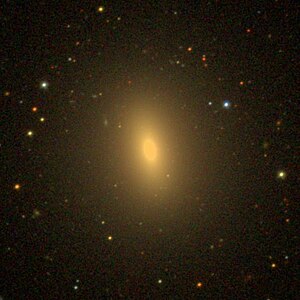NGC 5087
| Galaxy NGC 5087 |
|
|---|---|

|
|
| SDSS | |
| AladinLite | |
| Constellation | Virgin |
|
Position equinox : J2000.0 , epoch : J2000.0 |
|
| Right ascension | 13 h 20 m 24.9 s |
| declination | -20 ° 36 ′ 40 ″ |
| Appearance | |
| Morphological type | E + / LINER |
| Brightness (visual) | 11.4 mag |
| Brightness (B-band) | 12.4 mag |
| Angular expansion | 2.7 ′ × 2.2 ′ |
| Position angle | 10 ° |
| Surface brightness | 12.8 mag / arcmin² |
| Physical data | |
| Affiliation |
NGC 5084 group LGG 345 |
| Redshift | 0.006198 ± 0.000037 |
| Radial velocity | 1858 ± 11 km / s |
|
Stroke distance v rad / H 0 |
(78 ± 6) · 10 6 ly (23.8 ± 1.7) Mpc |
| history | |
| discovery | Wilhelm Herschel |
| Discovery date | April 8, 1788 |
| Catalog names | |
| NGC 5087 • UGCA 350 • PGC 46541 • ESO 576-035 • MCG -03-34-050 • IRAS 13177-2021 • 2MASX J13202496-2036396 • SGC 131743-2020.9 • GC 3494 • H III 724 • GALEX ASC J132024.96- 203638.7 • LDCE 964 NED010 | |
NGC 5087 is a 11.4 may bright Lenticular galaxy with active galaxies core from the Hubble type S0 in the constellation virgin on the ecliptic. It is estimated to be 78 million light years away from the Milky Way and about 60,000 light years in diameter. Together with four other galaxies, they form the small galaxy group LGG 345.
In the same area of the sky there is u. a. the galaxy NGC 5068 .
The object was discovered on April 8, 1788 by Wilhelm Herschel with an 18.7-inch reflector telescope , which she labeled “cF., vS., iF.” (Herschel's abbreviations for “considerably faint, very small, of an irregular figure ”).
